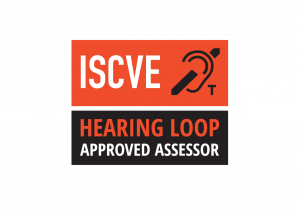
Loop Systems for Hearing Aid Users
Audio Frequency Induction Loop Systems (AFILS) are installed in places where hearing aid users will benefit from direct sound input to their personal hearing aid. The user switches their hearing aid to the “T”-position (Telecoil) – this reduces background noise and increases clarity of speech information and the enjoyment of live sound. The sound may come from dedicated microphones and/or the microphones used for a sound reinforcement (loudspeaker) system.
ISCVE Hearing loop assessment scheme
Phil Brown MInstSCVE is a full member of the Institute of Sound Communications & Visual Engineers and listed on the ISCVE Hearing Loop Assessment Scheme as an ISCVE hearing loop approved assessor. As an experienced installer he can assess your existing loop system and make appropriate recommendations if necessary.
Contact Phil to discuss your system…
Temporary Hearing Loop Installations that Provide a Genuine Benefit
We provide systems for hire – click here
Microphones for Audio Loop Systems
Hearing aids have internal microphone(s). The loop induction system is simply a way of transmitting sound directly to the hearing aid. This is only of benefit to a hearing aid user when the microphone(s) connected to the loop system are better placed to the source and therefore pick up less unwanted (ambient) sound than the microphone(s) built into the hearing aid. Ideally, microphones should normally be less than 1 metre from the talker in quiet locations and as close as 300mm in some noisier environments. In theatre (stage) applications, this can be up to several metres, but only when the actors project their voices and the background noise level is low. If more than three microphones are used for speech then an automatic microphone mixer is desirable; as recommended in Standards for best practice.
Examples where a loop system is used
- A church. The hearing aid user could be anywhere in the congregation. Microphones at the pulpit, lectern, altar etc., are much better placed than the built-in mic which is in the hearing aid where the user is sitting. The loop system’s microphones pick up more ‘wanted sound’, less ‘unwanted’ sound from background noises in the church, and less reverberant sound form the acoustic of the space. Adding an “Ambient Microphone” can reduce the effect of being isolated from the rest of the congregation, while still benefiting from the close mics of the talkers. – It’s as if each hearing aid user is stood next to the talkers!
- A reception counter. A microphone near the receptionist is much better located to pick up ‘wanted’ sound, and with less general background noise. This also avoids the receptionist having to raise their voice, which would increase the risk of other people overhearing the conversation. Special design of the loop cable route may be required, especially if the counter has a metal frame.
- A Boardroom. Multiple microphones will be required. These can be part of a video conference system, an output being programmed to feed the dedicated loop amplifier. A “low spill” loop is usually required to aid confidentiality, or Infra Red transmission with individual “neck loop” receivers to ensure very high confidentiality. We also offer radio frequency systems, encrypted for extremely high security.
- A meeting room with a divider. This requires some consideration as to the use of the room(s) when the dividing partition is open and closed. Note that when the divider is closed, they should be considered as two separate adjacent rooms.
- Adjacent rooms. If rooms are adjacent, or above one another, consideration of confidentiality will be needed. A simple “perimeter loop” is often used where spillover is not considered an issue. Complex interleaved “Low Spill” loop cable layouts may be requires with two loop amplifiers per room, with 90 degree phase shift [quadrature] between them. If not, hearing aid users may hear sound from the room they are in, and the adjacent room at the same time, rendering both the rooms unusable. We can advise if required.
- A TV Lounge. A loop can be very effective, allowing hearing aid users to switch to “T” position and receive direct sound from the TV. Other inputs can be added if required.
Note that only a hearing aid loop fed by a microphone or microphones that are much better placed than the hearing aid’s internal microphone, will be of benefit to the hearing aid user.
Hence; Loop Systems that use just a ceiling microphone may not offer any benefit or be compliant.
We also offer a full design and specification service. Considering a portable loop? – Read our advice leaflet.
Contact us for advice on…
- How to Choose an Induction Loop System for places with public access or in the workplace to comply with current requirements.
- Design or specification for an installation of an Audio Frequency Induction Loop System
- Loop System Design, perimeter, counter or “low spill” types
- Testing of an existing installation for compliance with Standards and ongoing maintenance
- Assistive listening systems, Infra-Red, Radio, WiFi streaming audio direct to Apple and Android smartphones
- Short term hire of Loop Systems, Infra-Red and Radio transmission systems – click here
- Loops for outdoor areas and marquees
- Temporary Hearing Loop Installations that Provide a Genuine Benefit
We are happy to advise on the most suitable technology for your application. For more information please contact us.
Useful references IEC60118-4 2014 British Standards 8300 – Code of Practice BS 7594:2011 Code of practice for audio-frequency induction-loop systems (AFILS) The Building Regulations 2010(12) Part M
